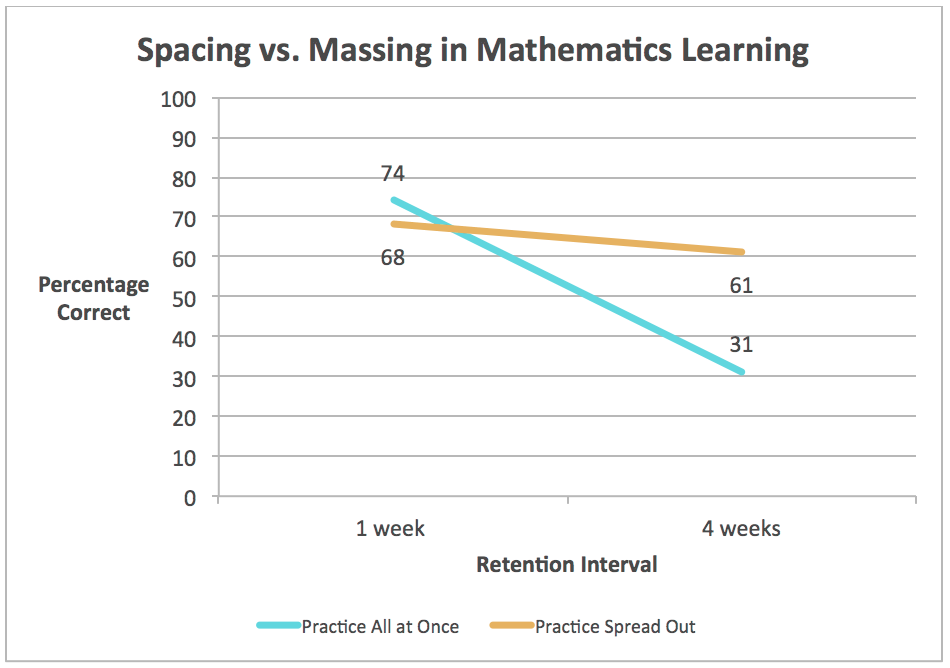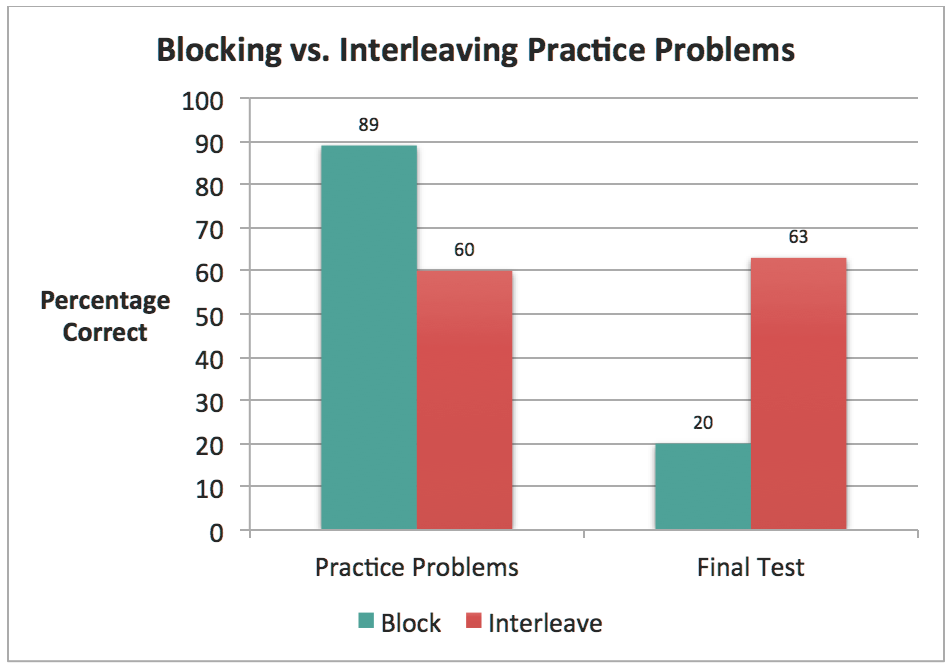A previous article argued, paradoxically, that remembering can cause forgetting. Today’s entry reverses the paradox: forgetting, you see, benefits remembering.
You read that right: if you want to remember, it helps to forget.
Let me explain.
Today in class, I taught my students a new verb tense (or a new technique for proving that lines are parallel, or the Ideal Gas Law). I’ve got twenty practice problems for them to do: what’s the best schedule for those problems?
When I learned French (and Geometry, and Chemistry) in high school, the answer was clear: do all the practicing right now. Whatever I studied in class today, I should practice tonight. In other words, I did those 20 practice problems then night after I learned the new material.
There is, of course, another conceptual option: I could ask my students to spread that practice out over time. They could do five problems tonight, and five tomorrow night, and so on.
Either plan seems plausible: which was is better? Happily, teachers don’t have to guess—we can look at research.
Here’s an example2. Hal Pashler’s research team had students come to his lab to learn an unusual math procedure, and practice it by doing 10 problems. A week later, half of those students returned to take a quiz on this procedure; the other half of the students took the same quiz…a MONTH later.
Then, Pasher had another group of students learn the same unusual math procedure—which they practiced by doing 5 problems (not ten, five). They all returned a week later, and did five more practice problems. A week later, half of those students returned to take the quiz; the other half of the students, again, took that quiz a month later.
So, both groups studied the same procedure, and did ten practice problems. The only difference: the schedule on which they did that practicing. Half of them did all the practice at once; the others spread their practice out.
Which group did better?
To put that picture into fewer than a thousand words: by spreading their study out, the second group remembered twice as much as the first group did.
Why did this technique work? Simply put, the second group had time to forget. The first group spent all their time learning. The second group learned, and then forgot, and then learned again. The forgetting benefitted ultimate remembering.
Two serious problems, however, might interfere with our ability to put this research result to practice.
Problem number 1: the students.
Pasher’s research result feels intuitive to most teachers—we’ve always known its’s better to spread practice out over time—but it feels profoundly counter-intuitive to students. They feel deeply in their gut that they should practice, practice, practice RIGHT NOW.
To help students see the benefits of spacing their practice, I regularly show them Pasher’s study. Students LOVE the idea that they can double the amount they remember (61%, instead of 31%) without doing any more practice problems.
Problem number 2: the syllabus.
Although “The Spacing Effect” sounds like a good idea when I think about any one topic, it leads to a potential problem with my syllabus. In the old days, I’d teach one topic on Monday, and then have my students practice that topic Monday night. On Tuesday we’d do the next topic, and they’d practice it on Tuesday night. In short, my syllabus looked like this:
Monday |
Tuesday |
Wednesday |
Thursday |
Friday |
|
In Class |
Topic A |
Topic B |
Topic C |
Topic D |
And So On |
Homework |
20 A Problems |
20 B Problems |
20 C Problems |
20 D Problems |
And So Forth |
However, if spread my practice out—perhaps by doing 5 problems per topic each night—my new syllabus will look like this:
Monday |
Tuesday |
Wednesday |
Thursday |
Friday |
|
In Class |
Topic A |
Topic B |
Topic C |
Topic D |
You |
Homework |
5 A Problems |
5 A Problems5 B Problems |
5 A Problems5 B Problems5 C Problems |
5 A Problems5 B Problems5 C Problems5 D Problems |
GetTheIdea |
The result: Thursday’s homework is a mess. It seems entirely possible that Spacing benefits learning when you do it with one topic in the psychology lab, but that—when teachers try it in the classroom—the muddled syllabus might undermine all the benefits that Spacing should provide. In brief: Spacing Good, Muddling Bad.
Researcher Doug Rohrer has investigated this question, and here’s what he found3.
He had one group of students come to his lab to learn four unusual math procedures. These students read one tutorial, and did practice problems for that procedure; they then read the next tutorial, and did those practice problems, and so forth.
Topic A |
Topic B |
Topic C |
Topic D |
|||
A Practice Problems |
B Practice Problems |
C Practice Problems |
D Practice Problems |
Another group read all four tutorials, and then did the same practice problems. However, their practice problems were all jumbled together:
Topic A |
Topic B |
Topic C |
Topic D |
|||||||||||||||
B |
D |
A |
C |
D |
B |
C |
A |
C |
B |
A |
D |
A |
C |
D |
B |
|||
You can see that the first group looks like my first syllabus: nicely organized; the second group looks like Thursday night on my second syllabus: a jumbled muddle. (Rohrer, more politely, calls this second structure “interleaved.”)
When it came to the practice problems, as I feared, the students in the jumbled group didn’t do very well: they got 60% of the problems right, compared to 88% in the traditionally organized group.
However, what happened when Rohrer’s groups came back two weeks later to take a test? The jumbled group, once again, remembered about 60%. The traditionally organized group remembered 20%.
Yes, 20%. Their score fell 66% in two weeks.
Why did that happen?
Two ideas seem most plausible.
First: Rohrer’s first group learned the four math procedures, but they didn’t practice deciding when to use each one. Because their practice problems always aligned with the technique they had just practiced, they never had to figure out when to use which one. So, two weeks later, they struggled to know which equation to use.
Second: Rohrer’s group had more opportunities to forget. Because their practice problems required them to switch from technique to technique, they never could get into a groove. Each problem, they had time to forget the techniques they weren’t practicing, and so had more opportunities to remember those techniques anew.
These two research pools lead to these conclusions: spacing benefits learning (because it allows forgetting). And, spacing requires a jumbled/interleaved syllabus—which also benefits learning (because, again, it allows forgetting).
A final note about research. The “Spacing Effect” is very well documented, and at this point is not controversial. The benefits of interleaving, however, have been shown by fewer studies; and some of the studies with high-school aged students have been equivocal1. But this much is clear; the combination of spacing & interleaving leads to more learning than the traditional syllabus.
Because, as you now remember, forgetting can help you learn.
References & Further Reading
- Dunlosky, J., Rawson, K. A., Marsh, E. J., Nathan, M. J., & Willingham, D. T. (2013). Improving students’ learning with effective learning techniques promising directions from cognitive and educational psychology. Psychological Science in the Public Interest, 14(1), 4-58. [Paper]
- Pashler, H., Rohrer, D., Cepeda, N. J., & Carpenter, S. K. (2007). Enhancing learning and retarding forgetting: Choices and consequences. Psychonomic bulletin & review, 14(2), 187-193. [Paper]
- Rohrer, D., & Pashler, H. (2010). Recent research on human learning challenges conventional instructional strategies.Educational Researcher, 39(5), 406-412. [Paper]





OMG THANK YOU SO MUCH! I NEEDED THIS FOR AN SPEECH AND THIS IS PROOF! THANK YOU
You’re welcome!